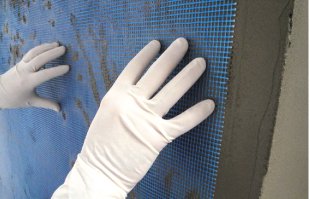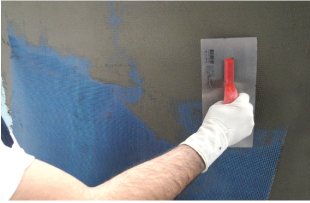What is Mesh Plaster in Sheathing, Thermal Insulation Applications?, What Is It?
Mesh plaster application in Sheathing and Thermal Insulation is done only in two stages as a single layer and a final layer.
The first layer of plaster should be applied after the doweling production. The temperature of the surface to be plastered should be between +5°C ~ +35°C, if the surface temperature is higher than +35°C, the program should not be made because the plaster will lose its water very quickly. The plaster should be protected from rain within the first 24 hours.
Plaster mesh is a carrier reinforcement material obtained by turning the fiber glass fiber with high alkali resistance into yarn, then weaving it and coating it with glue resin and coloring it. It is used on exterior and interior facades of buildings that requiresheathingAt the same time, plaster mesh is used as reinforcement carrier material in floor and ceiling insulation applicationscreated against hot and cold climatic conditions.

What is Plaster Mesh?, What is the Use of Plaster with Mesh?
Plaster mesh, which serves as plaster carrier reinforcement in construction, especially in jacketing construction , fully meets the requirements. Plaster mortars contain alkali. In order for a plaster mesh to be resistant to plaster, that is to alkali, it must be made of high-strength pure glass. In accordance with our understanding of quality, the plaster nets we use in the sheathing application are produced from the highest quality and high-strength glass fiber in the market. Plaster mesh is produced in accordance with CE norms, thermal insulation materials, jacketing plaster mesh standards in buildings.
The first layer of plaster should be smoothed with a 3×3 mm toothed notched steel trowel to obtain a homogeneous thickness of ~2.5 mm and the net should be lightly embedded in the plaster. Alkali resistant sheathing mesh should be embedded in the first layer of plaster slightly and 10 cm in horizontal and vertical joint areas. should be applied as overlapping. Weak edges should be strengthened by placing additional reinforcement mesh in the first layer of plaster in areas such as door or window edges, which are defined as weak areas on the facade.

After the first layer of plaster absorbs the water it contains slightly and before it completely dries, the second layer of plaster should be applied. In order to prevent the reinforcing mesh from being dislodged or embedded in the first layer of plaster during this process, the program is made by waiting for the first layer of plaster to shed its water slightly depending on the weather. The second layer of plaster should be smoothed with a steel trowel until the surface is smooth and there will be no trace of the trowel so that decorative plaster, grainy paint, etc. to be applied on the plaster production. so that the traces we call waves do not appear in the productions.
The plaster should be cured with water when rapid water loss occurs due to wind and temperature.
In a standard sheathing application, the consumption of the material used for mesh plaster should be 5 kg/m2. In the old days, mesh plaster application was also used in jamb coatings, but after acrylic based mineral plaster mortar, mesh plaster was no longer needed in jamb coating applications.
It is important to know that this material is not suitable for insulating your home or workplace. It depends on the installation point (roof, floor, windows, vents, etc.), the thickness of the thermal insulation materials to be used, moisture sensitive, thermal conductivity or R-value, thermal insulation material durability, toxicity level and many more. For this reason, it is important to seek advice from sheathing companies and experts before proceeding with the installation of the siding.







Metpor
info@metpordekor.com
Okunma Sayısı : 313